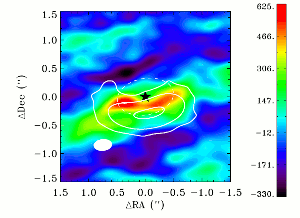- Details
- Published on 14 March 2014
Vol. 563
In section 10. Planets and planetary systems
Warm formaldehyde in the Ophiuchus IRS 48 transitional disk
 So-called transitional disks with a hole in the dust distribution
around the central star are a hot topic in the study of young
pre-main-sequence stars. One of the fascinating results obtained with
ALMA has been the discovery that the dust distribution of the disk surrounding the YSO Oph 48 is asymmetric, with an
arc of emission to the south of the central star. It is hypothesised
that this is caused by a sub-stellar companion or
planet at a distance of 20 AU from the central star. The article
by Van der Marel et al. highlighted in this issue shows that there
also is an arc of molecular line emission (caused by formaldehyde in this
case) slightly closer to the star than the continuum emission.
The kinematics and spatial distribution are consistent with a
ring of 60 AU radius, and the formaldehyde abundance of
10-8 relative to hydrogen suggests rapid ongoing chemical evolution
So-called transitional disks with a hole in the dust distribution
around the central star are a hot topic in the study of young
pre-main-sequence stars. One of the fascinating results obtained with
ALMA has been the discovery that the dust distribution of the disk surrounding the YSO Oph 48 is asymmetric, with an
arc of emission to the south of the central star. It is hypothesised
that this is caused by a sub-stellar companion or
planet at a distance of 20 AU from the central star. The article
by Van der Marel et al. highlighted in this issue shows that there
also is an arc of molecular line emission (caused by formaldehyde in this
case) slightly closer to the star than the continuum emission.
The kinematics and spatial distribution are consistent with a
ring of 60 AU radius, and the formaldehyde abundance of
10-8 relative to hydrogen suggests rapid ongoing chemical evolution


